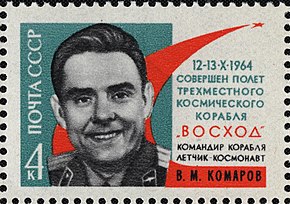
Back Sojoes 1 Afrikaans Союз 1 Bulgarian Soiuz 1 Catalan Sojuz 1 Czech Sojuz 1 Danish Sojus 1 German Sojuz 1 Esperanto Soyuz 1 Spanish Sojuz 1 Estonian Soiuz 1 Basque
 1964 commemorative stamp of Vladimir Komarov | |
| Mission type | Test flight |
|---|---|
| Operator | Experimental Design Bureau (OKB-1) |
| COSPAR ID | 1967-037A |
| SATCAT no. | 02759 |
| Mission duration | 1 day 2 hours 47 minutes 52 seconds |
| Orbits completed | 18 |
| Spacecraft properties | |
| Spacecraft | Soyuz 7K-OK No.1 |
| Spacecraft type | Soyuz 7K-OK |
| Manufacturer | Experimental Design Bureau (OKB-1) |
| Launch mass | 6450 kg |
| Landing mass | 2800 kg |
| Dimensions | 10 m long (with solar panels) 2.72 m wide |
| Crew | |
| Crew size | 1 |
| Members | Vladimir Komarov |
| Callsign | Рубин (Rubin – "Ruby") |
| Start of mission | |
| Launch date | 23 April 1967, 00:35:00 GMT |
| Rocket | Soyuz 11A511 s/n U15000-04 |
| Launch site | Baikonur, Site 1/5[1] |
| Contractor | Experimental Design Bureau (OKB-1) |
| End of mission | |
| Landing date | 24 April 1967, 03:22:52 GMT |
| Landing site | 3 km west of Karabutak, Orenburg Oblast, Russian SFSR, Soviet Union[2] |
| Orbital parameters | |
| Reference system | Geocentric orbit |
| Regime | Low Earth orbit |
| Perigee altitude | 197.0 km |
| Apogee altitude | 223.0 km |
| Inclination | 50.8° |
| Period | 88.7 minutes |
Soyuz 1 (Russian: Союз 1, Union 1) was a crewed spaceflight of the Soviet space program. Launched into orbit on 23 April 1967 carrying cosmonaut colonel Vladimir Komarov, Soyuz 1 was the first crewed flight of the Soyuz spacecraft. The flight was plagued with technical issues, and Komarov was killed when the descent module crashed into the ground due to a parachute failure. This was the first in-flight fatality in the history of spaceflight.
The original mission plan was complex, involving a rendezvous with Soyuz 2 and an exchange of crew members before returning to Earth. However, the launch of Soyuz 2 was called off due to thunderstorms.
- ^ "Baikonur LC1". Encyclopedia Astronautica. Archived from the original on 15 April 2009. Retrieved 4 March 2009.
- ^ Cite error: The named reference
googlellwas invoked but never defined (see the help page).